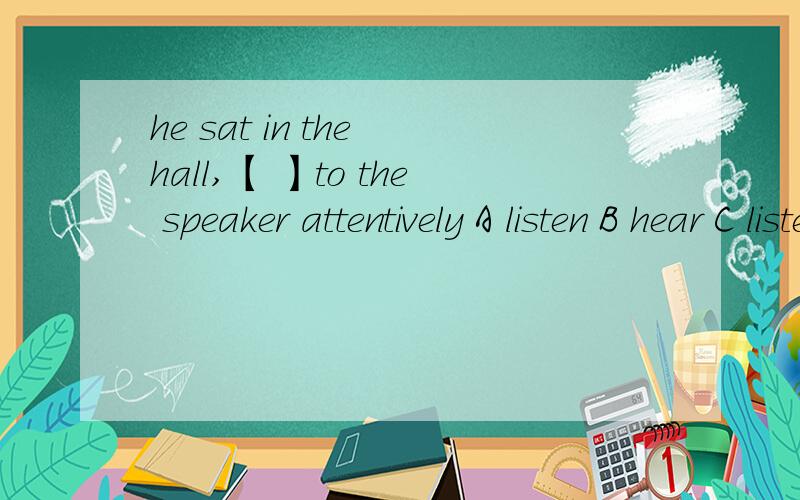he sat in the hall,【 】to the speaker attentively A listen B hear C listening D listened
来源:学生作业帮助网 编辑:作业帮 时间:2024/04/29 00:01:55

he sat in the hall,【 】to the speaker attentively A listen B hear C listening D listened
he sat in the hall,【 】to the speaker attentively A listen B hear C listening D listened
he sat in the hall,【 】to the speaker attentively A listen B hear C listening D listened
你好,本题选C
首先看到四个选项分别是原形(不定式)、现在分词、过去分词,判断考察的是非谓语动词,而且需要判断所填非谓语和其逻辑主语间的主被动关系
由于逻辑主语he和listen是主动关系,所以用现在分词listening
其语法作用是作伴随状语
有问题欢迎追问O(∩_∩)O~~
D
答案是C
我也看到了你又追问上一个回答者的问题,这里是后半句没有主语,只有一个主语,可是一个主语只能有一个谓语,按语法来讲listening和listened都是可以的,可是这里是主动与被动的区别,listening和listened在这里都可以作伴随状语,可是明显“听listen”与主语he是主动关系,如果后面是被动关系就用-ed了。这里经常出题来迷惑同学们,所以你以后碰到这种题,先看一...
全部展开
答案是C
我也看到了你又追问上一个回答者的问题,这里是后半句没有主语,只有一个主语,可是一个主语只能有一个谓语,按语法来讲listening和listened都是可以的,可是这里是主动与被动的区别,listening和listened在这里都可以作伴随状语,可是明显“听listen”与主语he是主动关系,如果后面是被动关系就用-ed了。这里经常出题来迷惑同学们,所以你以后碰到这种题,先看一下题里面是否有that, what,when等引导,如果没有,先看有几个谓语,如果前面是伴随状语没有谓语,就应该选相应时态的谓语,如果前面的句子有谓语,而且有没有that, what,when等引导,那么就是伴随状语,然后再考虑和主语之间是主动关系还是被动关系,主动则用-ing,被动则用-ed。
希望你以后遇到这样的题能有所帮助。希望能够帮到你。
收起
C listening 现在分词做伴随状语listened 怎么不行,,,,我认为是两句话,he sat in the hall, he listened to the speaker合起来,省略后半句的主语,也就是,he sat in the hall,listened to the speaker,这样想为什么不对??不是你所说的 如果表示并列的关系,句子应该是:He sat in the ...
全部展开
C listening 现在分词做伴随状语
收起